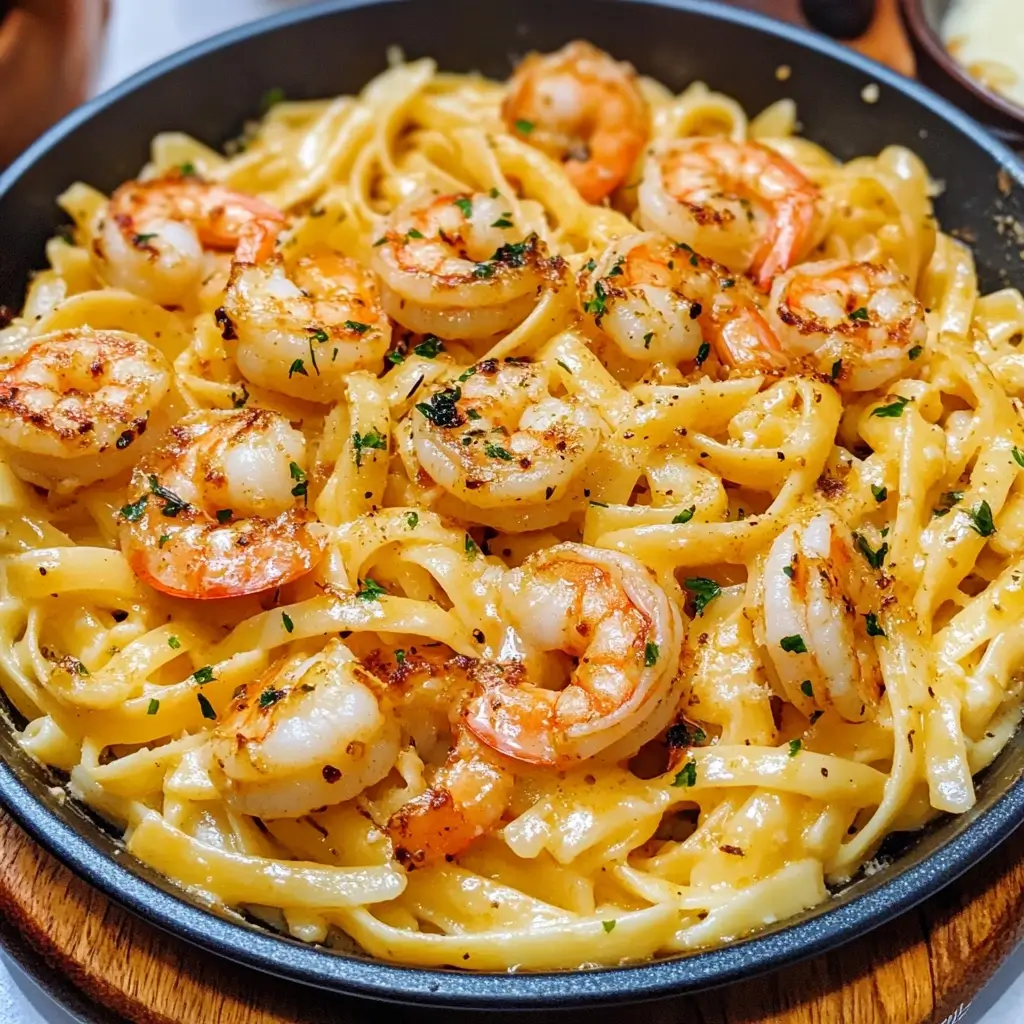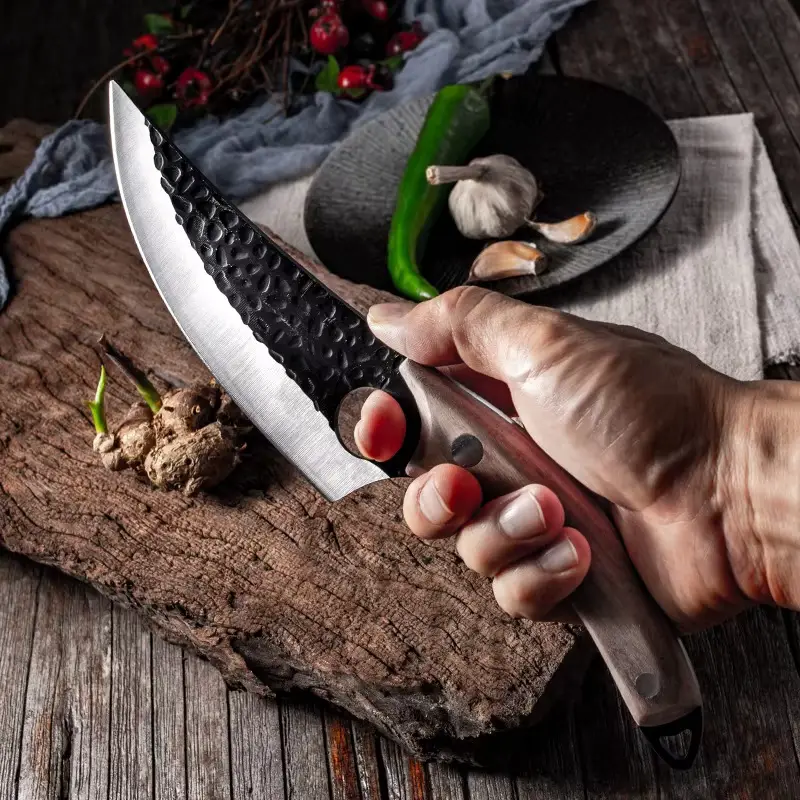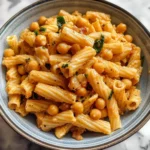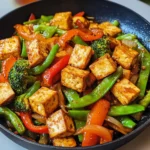There are some weeknight dinners that just become instant classics in your household, and this Garlic Butter Shrimp Pasta is undoubtedly one of them in mine. From the moment the aroma of sizzling garlic and butter fills the kitchen, you know you’re in for a treat. My family, even the pickiest eaters, devours this dish with gusto every single time. It’s the kind of meal that’s both incredibly satisfying and surprisingly simple to whip up, making it perfect for busy weeknights or a relaxed weekend dinner. The succulent shrimp bathed in a rich, garlicky butter sauce, tossed with perfectly cooked pasta – it’s a symphony of flavors and textures that truly sings. If you’re looking for a recipe that’s guaranteed to be a crowd-pleaser, requires minimal effort, and delivers maximum flavor, then look no further. This Garlic Butter Shrimp Pasta is about to become your new go-to meal.
Ingredients
To create this culinary masterpiece, you’ll need a handful of fresh, quality ingredients. The beauty of this recipe lies in its simplicity, allowing each element to shine. Here’s what you’ll need to gather:
- 1 pound Shrimp: For the best flavor and texture, use large or jumbo shrimp, peeled and deveined. You can choose to leave the tails on or off – it’s a matter of personal preference and presentation. Fresh or frozen shrimp both work well, just ensure frozen shrimp is fully thawed before cooking. Consider opting for shrimp that is sustainably sourced if possible.
- 1 pound Pasta: Linguine is the classic choice for shrimp pasta dishes, thanks to its slightly flattened shape that beautifully catches the sauce. However, spaghetti, fettuccine, or even penne and farfalle work wonderfully too. Choose your favorite pasta shape or whatever you have on hand. For a gluten-free option, use your preferred gluten-free pasta.
- 1 cup (2 sticks) Unsalted Butter: Butter is the heart of this rich sauce. Unsalted butter allows you to control the saltiness of the dish and ensures a pure, buttery flavor. High-quality butter will make a noticeable difference in the final taste.
- 8-10 cloves Garlic: Fresh garlic is non-negotiable for this recipe. Don’t skimp on the garlic! It’s what infuses the butter with that incredible aromatic flavor. Feel free to adjust the amount to your garlic preference, but 8-10 cloves provides a robust garlic flavor that is balanced by the butter and shrimp.
- 1/2 cup Dry White Wine (Optional): A splash of dry white wine like Pinot Grigio, Sauvignon Blanc, or Chardonnay adds a layer of complexity and acidity to the sauce, enhancing the overall flavor profile. If you prefer not to use wine, you can substitute it with chicken broth or simply omit it altogether.
- 1/4 cup Fresh Parsley: Fresh parsley, chopped, adds a vibrant herbaceous note and a pop of freshness to the dish. It also provides a lovely visual garnish. Italian flat-leaf parsley is recommended for its robust flavor.
- 1 Lemon: Fresh lemon juice brightens up the sauce with its acidity and citrusy notes. You’ll need the juice of about half a lemon, and optionally, some lemon zest for an extra layer of lemon flavor.
- 1/4 teaspoon Red Pepper Flakes (Optional): For a touch of heat, red pepper flakes add a subtle kick that complements the garlic and butter beautifully. Adjust the amount to your spice preference or omit it entirely if you prefer a milder dish.
- Salt and Freshly Ground Black Pepper: Essential for seasoning and enhancing all the flavors. Use kosher salt and freshly ground black pepper for the best taste.
- Olive Oil (Optional): A tablespoon or two of olive oil can be used in addition to butter for cooking the shrimp, or to prevent the butter from burning if you are using high heat.
Instructions
Creating this delectable Garlic Butter Shrimp Pasta is surprisingly straightforward and quick. Follow these step-by-step instructions to achieve pasta perfection:
- Cook the Pasta: Begin by bringing a large pot of salted water to a rolling boil. Adding salt to the pasta water is crucial for seasoning the pasta from the inside out. Once boiling, add your pasta and cook according to package directions until al dente. “Al dente” means “to the tooth” in Italian, and refers to pasta that is cooked through but still firm to the bite. This prevents the pasta from becoming mushy when combined with the sauce. Reserve about 1 cup of pasta water before draining the pasta. Pasta water is starchy and will help emulsify the sauce and create a silky texture. Drain the pasta and set aside.
- Prepare the Shrimp and Garlic: While the pasta is cooking, prepare your shrimp and garlic. If using frozen shrimp, ensure it is completely thawed. Pat the shrimp dry with paper towels to ensure they sear properly. Mince the garlic finely. Finely minced garlic will release its flavor quickly and evenly into the butter. Chop the fresh parsley. Zest and juice the lemon, if using.
- Sauté the Garlic in Butter: In a large skillet or pan, melt the butter over medium heat. Add the minced garlic to the melted butter and sauté for about 1-2 minutes, or until fragrant and lightly golden. Be careful not to burn the garlic, as burnt garlic can taste bitter. Sautéing the garlic in butter first infuses the butter with its delicious aroma and flavor, creating the base of the sauce.
- Add Shrimp and Cook: Increase the heat to medium-high. Add the shrimp to the skillet in a single layer, if possible. Avoid overcrowding the pan, as this will steam the shrimp instead of searing them. If necessary, cook the shrimp in batches. Cook the shrimp for 2-3 minutes per side, or until they turn pink and opaque and are cooked through. Overcooked shrimp can become rubbery, so be sure to cook them just until they are done. If using red pepper flakes, add them to the pan along with the shrimp.
- Deglaze with White Wine (Optional): If using white wine, pour it into the skillet after the shrimp are cooked. Scrape the bottom of the pan with a wooden spoon or spatula to deglaze and loosen any browned bits (fond) that have accumulated on the bottom. These browned bits are packed with flavor and will enhance the sauce. Let the wine simmer for about 1-2 minutes, allowing the alcohol to evaporate slightly and the flavors to meld.
- Combine Pasta and Sauce: Add the cooked pasta to the skillet with the shrimp and garlic butter sauce. Toss to combine, ensuring the pasta is evenly coated in the sauce. If the sauce seems too thick, add a little of the reserved pasta water, a tablespoon at a time, until the sauce reaches your desired consistency. The starch in the pasta water will help bind the sauce and create a creamy, emulsified texture.
- Finish with Lemon Juice and Parsley: Stir in the fresh lemon juice and chopped parsley. Taste and adjust seasoning with salt and freshly ground black pepper as needed. Lemon juice adds brightness and acidity, balancing the richness of the butter and garlic. Parsley adds freshness and a pop of color.
- Serve Immediately: Serve the Garlic Butter Shrimp Pasta immediately while it’s hot and flavorful. Garnish with extra parsley, a sprinkle of red pepper flakes (if desired), and grated Parmesan cheese, if you like. Serve in bowls and enjoy!
Nutrition Facts
(Please note that nutritional information is an estimate and can vary based on specific ingredients and serving sizes.)
- Servings: Approximately 4-6 servings
- Calories per Serving (Estimated): 500-700 calories
Approximate Nutritional Information per Serving (Based on 6 servings):
- Calories: 550-650
- Protein: 35-45g
- Fat: 25-35g
- Saturated Fat: 15-20g
- Cholesterol: 250-300mg
- Sodium: 500-800mg (varies based on added salt)
- Carbohydrates: 50-70g
- Fiber: 3-5g
- Sugar: 2-5g
Disclaimer: Nutritional information is an estimate and should be considered as a general guideline. For accurate nutritional information, use a nutrition calculator with the specific brands and quantities of ingredients you use.
Preparation Time
This recipe is perfect for a quick and delicious meal.
- Prep Time: 15-20 minutes (includes thawing shrimp, chopping garlic and parsley, zesting and juicing lemon)
- Cook Time: 20-25 minutes (includes cooking pasta and shrimp)
- Total Time: 35-45 minutes
How to Serve Garlic Butter Shrimp Pasta
Garlic Butter Shrimp Pasta is a complete and satisfying meal on its own, but you can elevate your dining experience by serving it with complementary side dishes and drinks. Here are some serving suggestions:
- Side Dishes:
- Crusty Bread: Serve with warm, crusty bread like baguette, ciabatta, or garlic bread for soaking up the delicious garlic butter sauce.
- Garlic Knots: For an extra garlicky treat, serve with homemade or store-bought garlic knots.
- Caesar Salad: A classic Caesar salad provides a refreshing and creamy contrast to the rich pasta.
- Simple Green Salad: A light and crisp green salad with a vinaigrette dressing offers a healthy and refreshing side.
- Roasted Asparagus or Broccoli: Roasted vegetables add a healthy element and textural contrast. Asparagus or broccoli pair particularly well with shrimp and garlic.
- Caprese Salad: A Caprese salad with fresh tomatoes, mozzarella, and basil provides a light and flavorful Italian-inspired side.
- Steamed Green Beans: Steamed green beans with a drizzle of olive oil and a sprinkle of salt and pepper are a simple and healthy side.
- Drinks:
- Dry White Wine: Continue with the white wine used in the recipe, such as Pinot Grigio, Sauvignon Blanc, or Chardonnay. The acidity of the wine complements the richness of the dish.
- Rosé Wine: A crisp rosé wine is another excellent pairing, especially in warmer weather.
- Sparkling Water with Lemon: For a non-alcoholic option, sparkling water with a squeeze of lemon juice is refreshing and palate-cleansing.
- Iced Tea: Unsweetened iced tea is a classic and refreshing choice that pairs well with seafood pasta.
- Light Beer: A light and crisp beer, like a Pilsner or Pale Lager, can also complement the flavors of the dish.
- Garnishes:
- Fresh Parsley: Sprinkle extra chopped fresh parsley over the pasta for a pop of color and freshness.
- Red Pepper Flakes: Add a pinch of red pepper flakes for a touch of heat, especially if you didn’t include them in the sauce.
- Grated Parmesan Cheese: Offer grated Parmesan cheese on the side for those who enjoy a cheesy topping.
- Lemon Wedges: Serve with lemon wedges for an extra squeeze of fresh lemon juice, if desired.
Additional Tips for Perfect Garlic Butter Shrimp Pasta
Elevate your Garlic Butter Shrimp Pasta to the next level with these helpful tips:
- Don’t Overcook the Shrimp: Shrimp cooks very quickly. Overcooked shrimp becomes rubbery and loses its succulent texture. Cook just until the shrimp turns pink and opaque, about 2-3 minutes per side. Err on the side of slightly undercooked, as they will continue to cook slightly when tossed with the hot pasta and sauce.
- Use High-Quality Ingredients: Since this recipe is simple, the quality of your ingredients truly matters. Use fresh, good-quality shrimp, butter, garlic, and parsley for the best flavor. Freshly squeezed lemon juice is also far superior to bottled lemon juice.
- Reserve Pasta Water: Don’t forget to reserve pasta water before draining the pasta! This starchy water is a secret weapon for creating a silky, emulsified sauce that clings beautifully to the pasta. Add it gradually to achieve your desired sauce consistency.
- Adjust Garlic to Your Preference: While the recipe calls for 8-10 cloves of garlic, you can adjust the amount to your personal taste. If you are a true garlic lover, feel free to add even more! Roasting the garlic cloves before mincing can also mellow out the garlic flavor and add a subtle sweetness.
- Customize with Add-Ins: This recipe is a fantastic base that you can easily customize. Consider adding:
- Vegetables: Sautéed spinach, cherry tomatoes, asparagus, or zucchini can be added to the pasta for extra nutrients and flavor. Add vegetables after the shrimp are cooked and before adding the pasta.
- Cheese: Grated Parmesan cheese, Pecorino Romano, or a sprinkle of crumbled feta cheese can add a salty and savory dimension.
- Spice: Increase the red pepper flakes for more heat, or add a pinch of cayenne pepper or a dash of hot sauce.
- Herbs: Experiment with other fresh herbs like basil, oregano, or thyme in addition to or instead of parsley.
- Creamy Sauce: For a creamier sauce, stir in a splash of heavy cream or half-and-half at the end, after adding the pasta.
Frequently Asked Questions (FAQ) about Garlic Butter Shrimp Pasta
Here are answers to some common questions you might have about making Garlic Butter Shrimp Pasta:
Q1: Can I use frozen shrimp for this recipe?
A: Yes, you can absolutely use frozen shrimp. Just make sure to thaw them completely before cooking. The best way to thaw frozen shrimp is to place them in a bowl of cold water for about 15-20 minutes, or until they are fully thawed. You can also thaw them overnight in the refrigerator. Pat the thawed shrimp dry with paper towels before cooking to ensure they sear properly and don’t steam in the pan.
Q2: What type of pasta is best for Garlic Butter Shrimp Pasta?
A: Linguine is the classic choice for shrimp pasta, as its slightly flattened shape is perfect for catching the sauce. However, spaghetti, fettuccine, angel hair, or even shorter pasta shapes like penne or farfalle will also work well. Choose your favorite pasta shape or whatever you have on hand. For a gluten-free option, use your preferred gluten-free pasta.
Q3: Can I make Garlic Butter Shrimp Pasta ahead of time?
A: Garlic Butter Shrimp Pasta is best enjoyed fresh and immediately after cooking. Shrimp is best served right away to prevent it from becoming rubbery. However, you can prep some components ahead of time. You can chop the garlic and parsley, zest and juice the lemon, and thaw the shrimp in advance. You can also cook the pasta ahead of time and toss it with a little olive oil to prevent sticking, then reheat it briefly in boiling water before adding it to the sauce. The sauce itself is best made fresh just before serving.
Q4: How can I make Garlic Butter Shrimp Pasta spicier?
A: There are several ways to add more spice to your Garlic Butter Shrimp Pasta:
* Increase Red Pepper Flakes: Add more red pepper flakes to the sauce while sautéing the garlic and shrimp. Start with a little more than the recipe calls for and adjust to your taste.
* Add Cayenne Pepper: A pinch of cayenne pepper added to the sauce will provide a more intense heat.
* Use Hot Sauce: A dash of your favorite hot sauce, like Tabasco or Sriracha, can be added to the sauce for extra spice and flavor.
* Fresh Chili Peppers: Finely chopped fresh chili peppers, like jalapeños or Serrano peppers, can be sautéed with the garlic for a fresh chili kick. Remember to remove the seeds and membranes for less heat.
Q5: Can I add vegetables to Garlic Butter Shrimp Pasta?
A: Absolutely! Adding vegetables is a great way to make this dish even more nutritious and flavorful. Some excellent vegetable additions include:
* Spinach: Add fresh spinach to the pan in the last few minutes of cooking, allowing it to wilt down.
* Cherry Tomatoes: Halved cherry tomatoes can be added along with the shrimp or sautéed separately and added at the end.
* Asparagus: Blanched or roasted asparagus can be added to the pasta for a spring-inspired dish.
* Zucchini: Sliced or diced zucchini can be sautéed with the garlic before adding the shrimp.
* Broccoli: Steamed or roasted broccoli florets can be tossed with the pasta and sauce.
* Artichoke Hearts: Canned or marinated artichoke hearts add a briny and slightly tangy flavor.
Feel free to experiment with different vegetables to find your favorite combinations! Enjoy making and savoring this delightful Garlic Butter Shrimp Pasta. It’s a recipe that’s sure to become a family favorite for years to come!
Print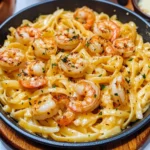
Garlic Butter Shrimp Pasta
Ingredients
To create this culinary masterpiece, you’ll need a handful of fresh, quality ingredients. The beauty of this recipe lies in its simplicity, allowing each element to shine. Here’s what you’ll need to gather:
- 1 pound Shrimp: For the best flavor and texture, use large or jumbo shrimp, peeled and deveined. You can choose to leave the tails on or off – it’s a matter of personal preference and presentation. Fresh or frozen shrimp both work well, just ensure frozen shrimp is fully thawed before cooking. Consider opting for shrimp that is sustainably sourced if possible.
- 1 pound Pasta: Linguine is the classic choice for shrimp pasta dishes, thanks to its slightly flattened shape that beautifully catches the sauce. However, spaghetti, fettuccine, or even penne and farfalle work wonderfully too. Choose your favorite pasta shape or whatever you have on hand. For a gluten-free option, use your preferred gluten-free pasta.
- 1 cup (2 sticks) Unsalted Butter: Butter is the heart of this rich sauce. Unsalted butter allows you to control the saltiness of the dish and ensures a pure, buttery flavor. High-quality butter will make a noticeable difference in the final taste.
- 8–10 cloves Garlic: Fresh garlic is non-negotiable for this recipe. Don’t skimp on the garlic! It’s what infuses the butter with that incredible aromatic flavor. Feel free to adjust the amount to your garlic preference, but 8-10 cloves provides a robust garlic flavor that is balanced by the butter and shrimp.
- 1/2 cup Dry White Wine (Optional): A splash of dry white wine like Pinot Grigio, Sauvignon Blanc, or Chardonnay adds a layer of complexity and acidity to the sauce, enhancing the overall flavor profile. If you prefer not to use wine, you can substitute it with chicken broth or simply omit it altogether.
- 1/4 cup Fresh Parsley: Fresh parsley, chopped, adds a vibrant herbaceous note and a pop of freshness to the dish. It also provides a lovely visual garnish. Italian flat-leaf parsley is recommended for its robust flavor.
- 1 Lemon: Fresh lemon juice brightens up the sauce with its acidity and citrusy notes. You’ll need the juice of about half a lemon, and optionally, some lemon zest for an extra layer of lemon flavor.
- 1/4 teaspoon Red Pepper Flakes (Optional): For a touch of heat, red pepper flakes add a subtle kick that complements the garlic and butter beautifully. Adjust the amount to your spice preference or omit it entirely if you prefer a milder dish.
- Salt and Freshly Ground Black Pepper: Essential for seasoning and enhancing all the flavors. Use kosher salt and freshly ground black pepper for the best taste.
- Olive Oil (Optional): A tablespoon or two of olive oil can be used in addition to butter for cooking the shrimp, or to prevent the butter from burning if you are using high heat.
Instructions
Creating this delectable Garlic Butter Shrimp Pasta is surprisingly straightforward and quick. Follow these step-by-step instructions to achieve pasta perfection:
- Cook the Pasta: Begin by bringing a large pot of salted water to a rolling boil. Adding salt to the pasta water is crucial for seasoning the pasta from the inside out. Once boiling, add your pasta and cook according to package directions until al dente. “Al dente” means “to the tooth” in Italian, and refers to pasta that is cooked through but still firm to the bite. This prevents the pasta from becoming mushy when combined with the sauce. Reserve about 1 cup of pasta water before draining the pasta. Pasta water is starchy and will help emulsify the sauce and create a silky texture. Drain the pasta and set aside.
- Prepare the Shrimp and Garlic: While the pasta is cooking, prepare your shrimp and garlic. If using frozen shrimp, ensure it is completely thawed. Pat the shrimp dry with paper towels to ensure they sear properly. Mince the garlic finely. Finely minced garlic will release its flavor quickly and evenly into the butter. Chop the fresh parsley. Zest and juice the lemon, if using.
- Sauté the Garlic in Butter: In a large skillet or pan, melt the butter over medium heat. Add the minced garlic to the melted butter and sauté for about 1-2 minutes, or until fragrant and lightly golden. Be careful not to burn the garlic, as burnt garlic can taste bitter. Sautéing the garlic in butter first infuses the butter with its delicious aroma and flavor, creating the base of the sauce.
- Add Shrimp and Cook: Increase the heat to medium-high. Add the shrimp to the skillet in a single layer, if possible. Avoid overcrowding the pan, as this will steam the shrimp instead of searing them. If necessary, cook the shrimp in batches. Cook the shrimp for 2-3 minutes per side, or until they turn pink and opaque and are cooked through. Overcooked shrimp can become rubbery, so be sure to cook them just until they are done. If using red pepper flakes, add them to the pan along with the shrimp.
- Deglaze with White Wine (Optional): If using white wine, pour it into the skillet after the shrimp are cooked. Scrape the bottom of the pan with a wooden spoon or spatula to deglaze and loosen any browned bits (fond) that have accumulated on the bottom. These browned bits are packed with flavor and will enhance the sauce. Let the wine simmer for about 1-2 minutes, allowing the alcohol to evaporate slightly and the flavors to meld.
- Combine Pasta and Sauce: Add the cooked pasta to the skillet with the shrimp and garlic butter sauce. Toss to combine, ensuring the pasta is evenly coated in the sauce. If the sauce seems too thick, add a little of the reserved pasta water, a tablespoon at a time, until the sauce reaches your desired consistency. The starch in the pasta water will help bind the sauce and create a creamy, emulsified texture.
- Finish with Lemon Juice and Parsley: Stir in the fresh lemon juice and chopped parsley. Taste and adjust seasoning with salt and freshly ground black pepper as needed. Lemon juice adds brightness and acidity, balancing the richness of the butter and garlic. Parsley adds freshness and a pop of color.
- Serve Immediately: Serve the Garlic Butter Shrimp Pasta immediately while it’s hot and flavorful. Garnish with extra parsley, a sprinkle of red pepper flakes (if desired), and grated Parmesan cheese, if you like. Serve in bowls and enjoy!
Nutrition
- Serving Size: one normal portion
- Calories: 700
- Fat: 35g
- Saturated Fat: 20g
- Carbohydrates: 70g
- Protein: 45g
- Cholesterol: 300mg


